Curation
This document discusses the use of repetition in art through various examples. It explains that repetition is used by artists to create moods like movement, anxiety, or a busy scene. Specific works mentioned include a Roman relief using repetition of lines to depict a crowd, Florence Cathedral using repeating geometric patterns for structure and visual effect, and Durer's woodcut with extensive line repetition to animate a battle. The document also discusses Monet repeating colors and Renoir repeating figures to depict movement, and Munch repeating lines to represent emotions. It analyzes Warhol's soup cans using repetition to comment on mass production and consumerism. Overall the document illustrates how repetition is strategically employed across different artworks and eras to achieve various artistic goals
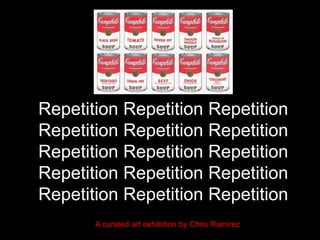
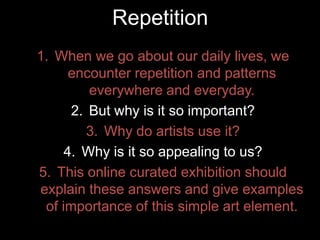
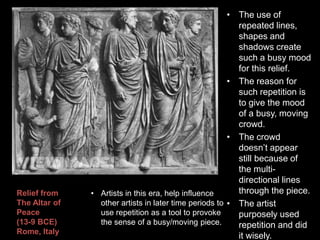
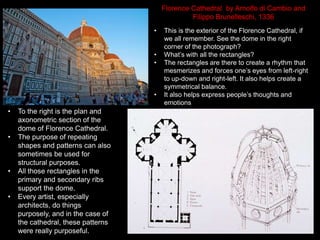


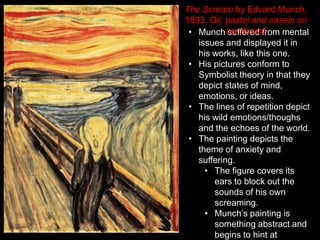
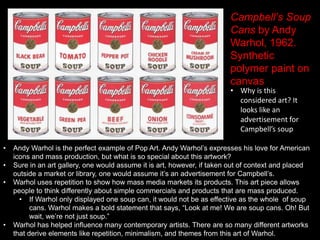
Recommended
More Related Content
What's hot (19)
Viewers also liked (6)
Similar to Curation (20)
Curation
- 1. Repetition Repetition Repetition Repetition Repetition Repetition Repetition Repetition Repetition Repetition Repetition Repetition Repetition Repetition Repetition A curated art exhibition by Chris Ramirez
- 2. 1. When we go about our daily lives, we encounter repetition and patterns everywhere and everyday. 2. But why is it so important? 3. Why do artists use it? 4. Why is it so appealing to us? 5. This online curated exhibition should explain these answers and give examples of importance of this simple art element. Repetition
- 3. • The use of repeated lines, shapes and shadows create such a busy mood for this relief. • The reason for such repetition is to give the mood of a busy, moving crowd. • The crowd doesn’t appear still because of the multi- directional lines through the piece. • The artist purposely used repetition and did it wisely. Relief from The Altar of Peace (13-9 BCE) Rome, Italy • Artists in this era, help influence other artists in later time periods to use repetition as a tool to provoke the sense of a busy/moving piece.
- 4. • This is the exterior of the Florence Cathedral, if we all remember. See the dome in the right corner of the photograph? • What’s with all the rectangles? • The rectangles are there to create a rhythm that mesmerizes and forces one’s eyes from left-right to up-down and right-left. It also helps create a symmetrical balance. • It also helps express people’s thoughts and emotions • To the right is the plan and axonometric section of the dome of Florence Cathedral. • The purpose of repeating shapes and patterns can also sometimes be used for structural purposes. • All those rectangles in the primary and secondary ribs support the dome. • Every artist, especially architects, do things purposely, and in the case of the cathedral, these patterns were really purposeful. Florence Cathedral by Arnolfo di Cambio and Filippo Brunelleschi, 1336
- 5. • In this detailed print (made from an engraving of a woodcut) is an example of the artist using repetition to create a rhythm and sense of movement. • The horizontal lines across the print induce the idea that the wind is blowing past these warriors who are ready for action. • Imagine engraving all these lines by hand? Durer must have a lot of patience. • This artwork is so busy because of the extensive line repetition. • One may not know where to start looking at when viewing this piece. My eyes keep moving around the entire print. • The artist intended his print to appear so busy. • An apocalypse battle would be so busy one wouldn’t know Four Horsemen of the Apocalypse by Albrect Durer 1497-1498 Woodcut Print
- 6. • From the blue lines in the little girl’s outfit (foreground) to the shifting pattern of lights and darks on the floor, there is repetition everywhere in this painting. • The lights on the above, the leaves in the trees above and especially the amount of faces and bodies are even repeated various times. • The shifting shadows on the floor help animate the scene. Moulin de la Galette - Pierre-Auguste Renoir, 1876. Oil on Canvas • The artist Renoir intended this painting to appear so repetitive to create the mood of movement and animation. The painting
- 7. • Munch suffered from mental issues and displayed it in his works, like this one. • His pictures conform to Symbolist theory in that they depict states of mind, emotions, or ideas. • The lines of repetition depict his wild emotions/thoughs and the echoes of the world. • The painting depicts the theme of anxiety and suffering. • The figure covers its ears to block out the sounds of his own screaming. • Munch’s painting is something abstract and begins to hint at The Scream by Edvard Munch, 1893. Oil, pastel and casein on cardboard
- 8. Campbell’s Soup Cans by Andy Warhol, 1962. Synthetic polymer paint on canvas • Why is this considered art? It looks like an advertisement for Campbell’s soup • Andy Warhol is the perfect example of Pop Art. Andy Warhol’s expresses his love for American icons and mass production, but what is so special about this artwork? • Sure in an art gallery, one would assume it is art, however, if taken out of context and placed outside a market or library, one would assume it’s an advertisement for Campbell’s. • Warhol uses repetition to show how mass media markets its products. This art piece allows people to think differently about simple commercials and products that are mass produced. • If Warhol only displayed one soup can, it would not be as effective as the whole of soup cans. Warhol makes a bold statement that says, “Look at me! We are soup cans. Oh! But wait, we’re not just soup.” • Warhol has helped influence many contemporary artists. There are so many different artworks that derive elements like repetition, minimalism, and themes from this art of Warhol.
